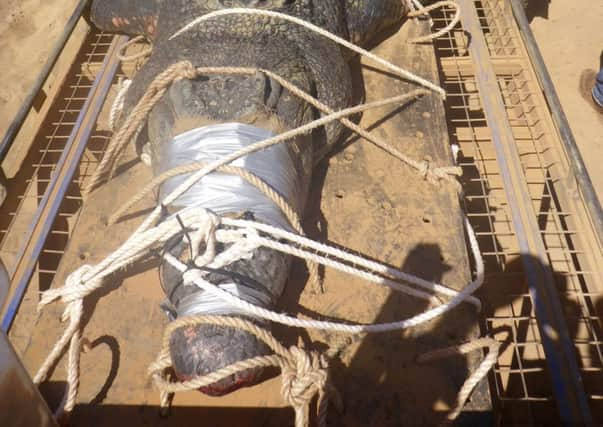Australian rangers capture massive crocodile in tourist area


The crocodile was captured in a region popular with tourists that is considered relatively safe from the killer predators.
Northern Territory Parks and Wildlife said it had trapped the 600kg (1,300lb) reptile more than 300 kilometres (185 miles) from the ocean and only 30 kilometres (19 miles) downstream from Katherine Gorge, a major tourist attraction outside the Northern Territory town of Katherine.
Advertisement
Hide AdAdvertisement
Hide AdTourists swim, canoe and take cruises in the gorge among freshwater crocodiles, a different species that are small, timid and rarely harm humans.
Mid-year is the peak tourist season.
Ranger John Burke said authorities had been hunting the large crocodile in the area for a decade.
“We’ve called it a lot of things over the years because it’s been so hard to catch,” Mr Burke said.
READ MORE: (https://www.scotsman.com/news/environment/soaring-seabird-numbers-boost-island-wildlife-reserve-1-4760326|Soaring seabird numbers boost island wildlife reserve}
READ MORE: (https://www.scotsman.com/news/environment/dna-to-be-used-in-tracking-wildlife-criminals-1-4728025|SNA to be used in tracking wildlife criminals}
“On record, this is the biggest saltwater crocodile removed from the Katherine management zone,” he added, referring to the part of the river where saltwater crocodiles, a protected species, are trapped because they are too close to human populations.
Northern Territory-based crocodile expert Grahame Webb said saltwater crocodiles, also known as estuarine crocodiles, were heading further upstream into fresh water river systems as their population has boomed since they were protected by federal law in 1971.
While large crocodiles are territorial, Mr Webb suspected the trapped reptile had moved to and from the area where it was caught during the past 10 years.
Advertisement
Hide AdAdvertisement
Hide AdSatellite tracking had shown one crocodile tagged in a Northern Territory waterhole had swum 900 kilometres (560 miles), for unknown reasons, before returning to the same place.
“That sort of croc, in my opinion, is the most dangerous to people,” Mr Webb said.
“In areas where they’re at best low densities, someone won’t have seen one for a long, long time and they think they’re safe and they’re not necessarily safe.”
Mr Webb said the capture so close to tourists demonstrated that the government protection programme worked.
“It’s worrying, but it’s good that they’ve got an active programme and they’ve got active traps,” Mr Webb said.
The reptile has been taken to a crocodile farm outside Katherine where it is likely to become a tourist attraction.
Crocodiles are farmed for their meat and hides, but large and battle-scarred crocodiles are usually unsuitable for the handbag market.
Since crocodiles became a protected species, crocodile numbers in the Northern Territory have exploded from 3,000 to an estimated 80,000 to 100,000.
Because saltwater crocodiles can live for up to 70 years and grow throughout their lives, reaching up to seven metres (23ft), the proportion of large crocodiles is also rising.